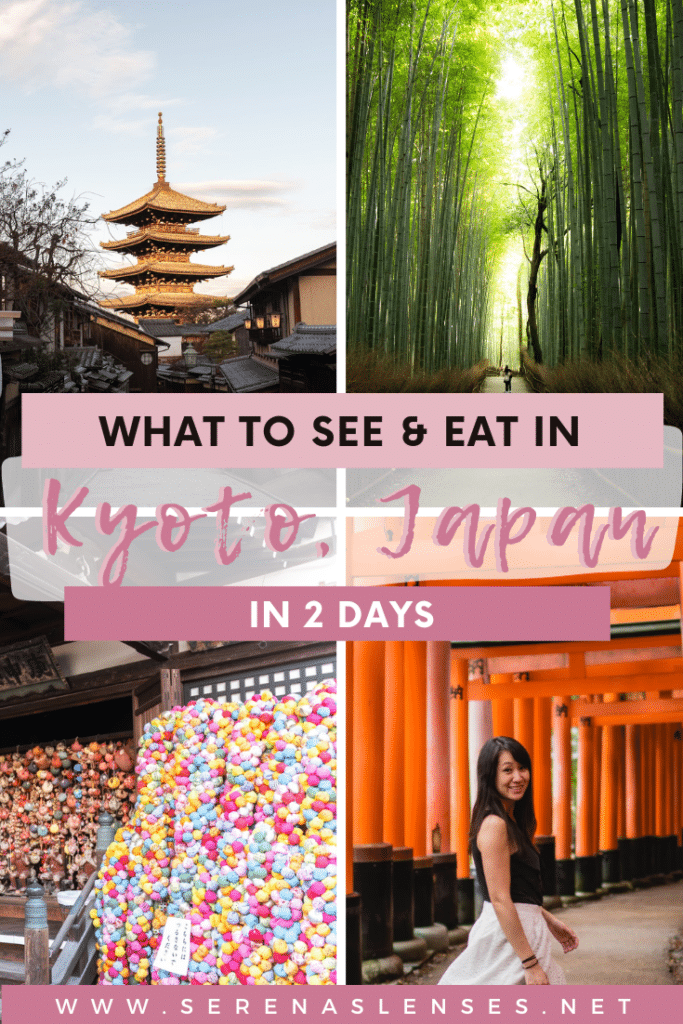Essential Kyoto 2 Day Itinerary: Best Way to Spend 2 Days in Kyoto

Have 2 days in Kyoto and wondering what to do? This 2 day Kyoto itinerary not only shows you the best things to do, but also where to stay, how to get around, and other practical Kyoto travel information.
Kyoto is always on everyone’s first time Japan itinerary, and for good reasons. There is just so much you can do and see in Kyoto, from famous red torii gates to beautiful and historical temples to lush bamboo forests and hiking trails. It is also the gateway to many day trips to nearby cities and towns.
If you want to escape from the hustling and bustling of Tokyo and Osaka or if you just want to feel like you’ve stepped back in time to ancient Japan, then you would love Kyoto.
I have visited Kyoto 3 times total and each time I got to explore something more, ate something new and developed a new perspective. With this super efficient Kyoto itinerary, I will show you how to see the best sights and eat the best food in Kyoto.
You will find other travel information to make your Kyoto trip more smooth and hassle free. This is a massive guide with [almost] everything you need to know to have an amazing two days in Kyoto.
This blog contains occasional affiliate links, where I receive a small commission on sales of the products/hotels that are linked at no additional cost to you. In addition, as an Amazon Associate, I earn from qualifying purchases.

Map of Kyoto Attractions for 2 Days in Kyoto
Unless you are Japanese or if you know Kyoto really well (in that case you don’t even need this 2 day Kyoto itinerary!), you probably will get confused with all the names of the temples and attractions.
For me I always like a visual map so I can see where everything is to better plan my itineraries. I like to group all the attractions by location so I can have a very efficient itinerary.
So in the map below, I pinned all the major things to see in Kyoto (with different colors!) as well as things to eat in Kyoto (with the red pins with a food symbol of course). Hope this map of Kyoto can help you visualize where things are!
2 Day Kyoto Itinerary Overview
Since you only have 2 days in Kyoto, if you want to see the major attractions and sites in Kyoto you will have to wake up early and can be quite busy throughout the two days.
Below is my suggestion on what you can do in Kyoto in 2 days based on my experience visiting multiple times. You can always scale back and take out a few things if you prefer slow traveling and want to take your time somewhere.
Day 1 in Kyoto (purple pins on the Kyoto map above)
- Fushimi Inari early in the morning
- Nishiki Market
- Temple Hopping in Northern Higashiyama
- Explore Gion & Pontocho at Night
Day 2 in Kyoto (orange pins on the Kyoto map above)
- Explore Southern Higashiyama
- Maruyama Park & Shogunzuka Mound
- Kinkakuji
- More time in Gion
Read next: Complete 2 Day Tokyo Itinerary
How to Spend 2 Day in Kyoto [Detailed Version]
Now without further ado, let’s dive into this super detailed two day itinerary for Kyoto! As mentioned above, this is a pretty packed itinerary aimed at maximizing your time in Kyoto. But of course, just keep this in your back pocket so you know roughly what you can do. If you want to stay longer (or skip things), feel free!
This 2 day Kyoto itinerary also assumes you have two full days, no half days, no waking up at 10am. If slow travel is your style, you will need to skip some of the things mentioned below. But if you are the type that is willing to get up early to get the best photos and see as much as you can, then this is the perfect 2 day Kyoto itinerary for you.
Day 1 of 2 days in Kyoto
During your first day in Kyoto, you will get up bright and early and take the train to Fushimi Inari to see the famous red torii gates, then head back to Kyoto to check out Nishiki Market and grab a bite.
You will spend the afternoon temple hopping in Northern Higashiyama and walk down the famous Philosopher’s Path. Spend the evening exploring the beautiful and historical Gion and grab a drink at Pontocho to end your perfect first day in Kyoto.
Early Morning: Fushimi Inari

Fushimi Inari is the most iconic tourist attraction near Kyoto in Japan. Known for its endless red torii gates, Fushimi Inari is a sight not to be missed for any trip to Kyoto.

Located on the foothill of Mount Inari, Fushimi Inari is a shrine dedicated to the Shinto God of Inari, a god of harvest. The thousands of red torii gates form a trail to the top of Mount Inari at about 233 meters high. As you walk up the trail, you will see the red gates with no writings on them; but if you turn around, you will see the names and companies who donated.
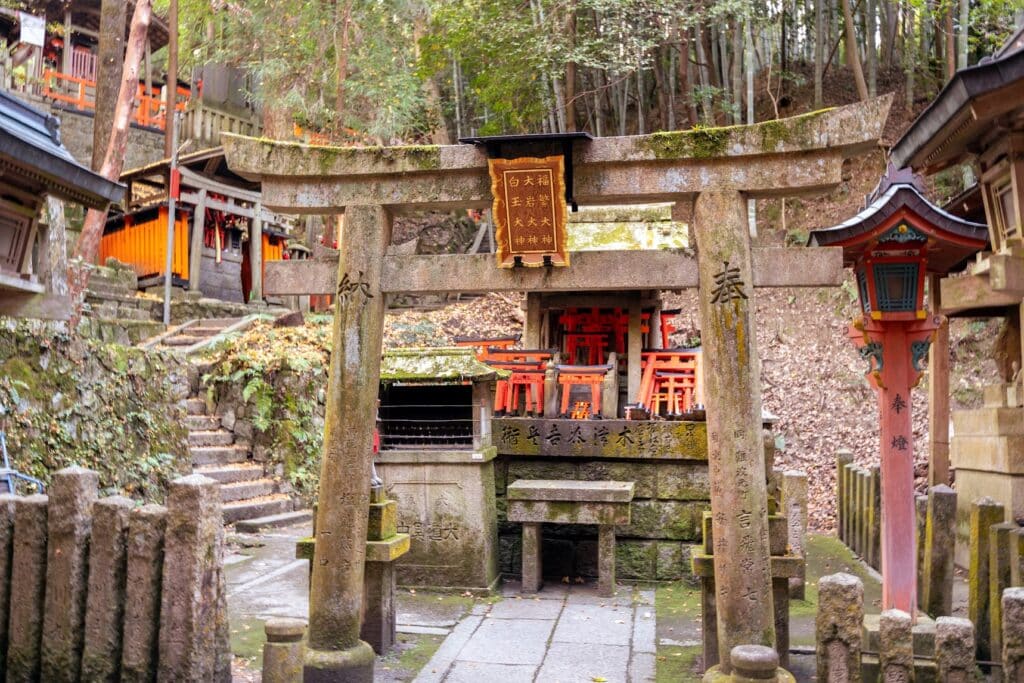
The shrine does not only have torii gates, as you walk around, you will find small shrines, altars and fox statues all over the grounds. Foxes are known as God Inari’s messengers.

How to get to Fushimi Inari from Kyoto: Take the local Nara Line from Kyoto Station for 2 stops, get off at Inari Station. The train ride takes 5 minutes and costs ¥150 ($1-2 USD). You can use Google Maps for directions.

Best time to visit Fushimi Inari: Due to its popularity, if you want to avoid people and get good photos then arrive at no later than 7:30am in the morning. If it is crowded when you visit, hike up the trail and you should see less and less people the higher you go.
Kimono Rental in Kyoto: If you want to have that traditional Japanese experience you can rent a Kimono for the day (or even overnight). It is perfect for taking photos around Kyoto. You can book it here.
Mid Morning: Nishiki Market (錦市場)
Hours: 10am to 6pm; many stalls are closed Wednesday or Sunday
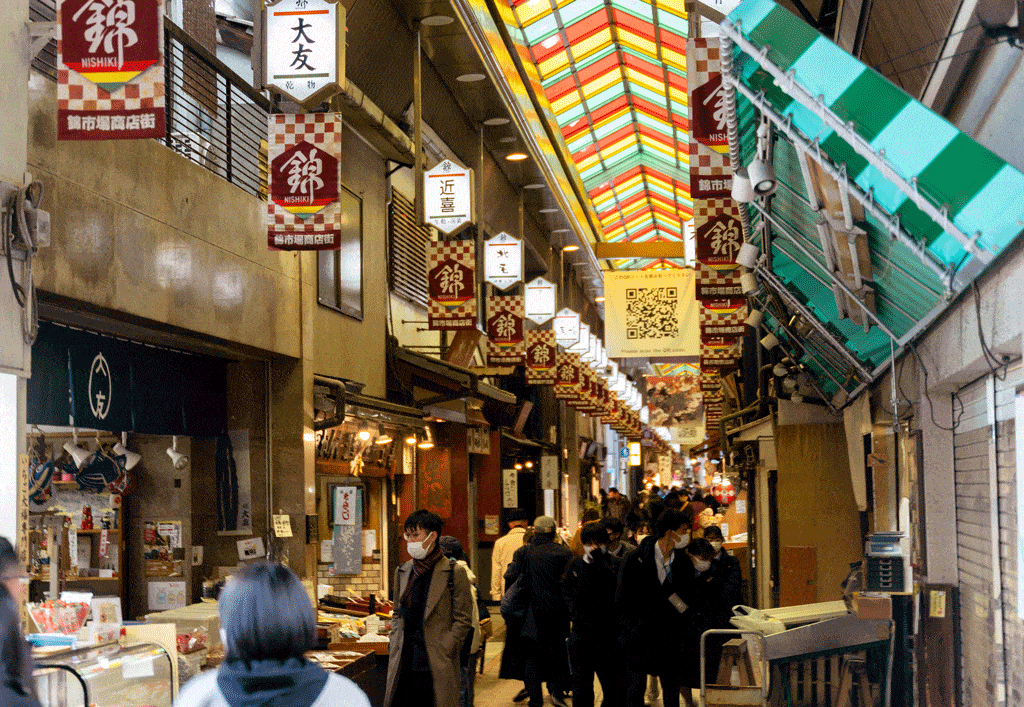
Once you finish exploring Fushimi Inari, you will take the train back to Kyoto and visit Kyoto’s most famous food market: Nishiki Market.
Nishiki Market is a 5 block long indoor covered arcade that has been around for 400 years. You will find over 100 vendors and food stalls in Nishiki Market. But Nishiki Market does not only sell food, you will find fresh produce, spices, dried food, souvenirs and even clothing items and shoes at Nishiki Market.





But if you were to eat at Nishiki, you have a lot of options! There are so many stalls and lots of specialties, such as yuba krokke (croquettes), tempura, rice crackers, tofu skin (yuba), mochi, ice cream, fish cakes, soy milk donuts, gluten bun (fu manju), sea bream skewer and pike eel tempura.

At the end of Nishiki Market is a small Shinto shrine called Nishiki-Tenmangu Shrine (錦天満宮), a shrine dedicated to the God of Scholar Tenjin.
Afternoon: Visit Temples in Northern Higashiyama
As the cultural capital of Japan, Kyoto is known for its beautiful and historical shrines and temples. There are temples in many different areas of Kyoto (it is a big city after all), but most of the popular shrines are concentrated in the downtown area called Higashiyama.
Most people break down Higashiyama into two areas: north Higashiyama and south Higashiyama. Today we will see temples in North Higashiyama.
Some of the most important shrines and temples in Northern Higashiyama include:
- Nanzen-ji Temple
- Eikan-do (Zenrin-ji) temple
- Honen-In Temple
- Ginkakuji (Silver Pavilion)
- Philosopher’s Path connecting Eikan-do temple to Ginkakuji
Nanzen-ji Temple (南禅寺)

Nanzen-ji Temple is a well known Zen temple in Higashiyama in Kyoto. It was originally built as Emperor Kameyama’s retirement villa but later turned into the head temple of the Rinzai Zen sect.

One of the most prominent structures at Nanzen-ji Temple is the Sanmon gate, a two story gate that serves as the main entrance to the temple area. Sanmon Gate was reconstructed in 1628 after it was destroyed by the government in the 1300s. You can climb to the top of the gate to have a view of the temple ground and the surrounding area.

Another important building at Nanzen-ji Temple is the Hojo, the head priest’s quarters and its rock garden. You will also find a brick aqueduct that was built to carry irrigation water to Kyoto.
Eikan-do (Zenrin-ji) temple (永観堂/ 禅林寺)

Eikan-do Temple is another Buddhist Zen temple in Kyoto, not too far from Nanzen-ji Temple. Originally built as a villa to a court noble, Eikan-do temple was later founded as a Shingon sect temple by the monk Shinsho. The temple was eventually converted to the Jodo sect.

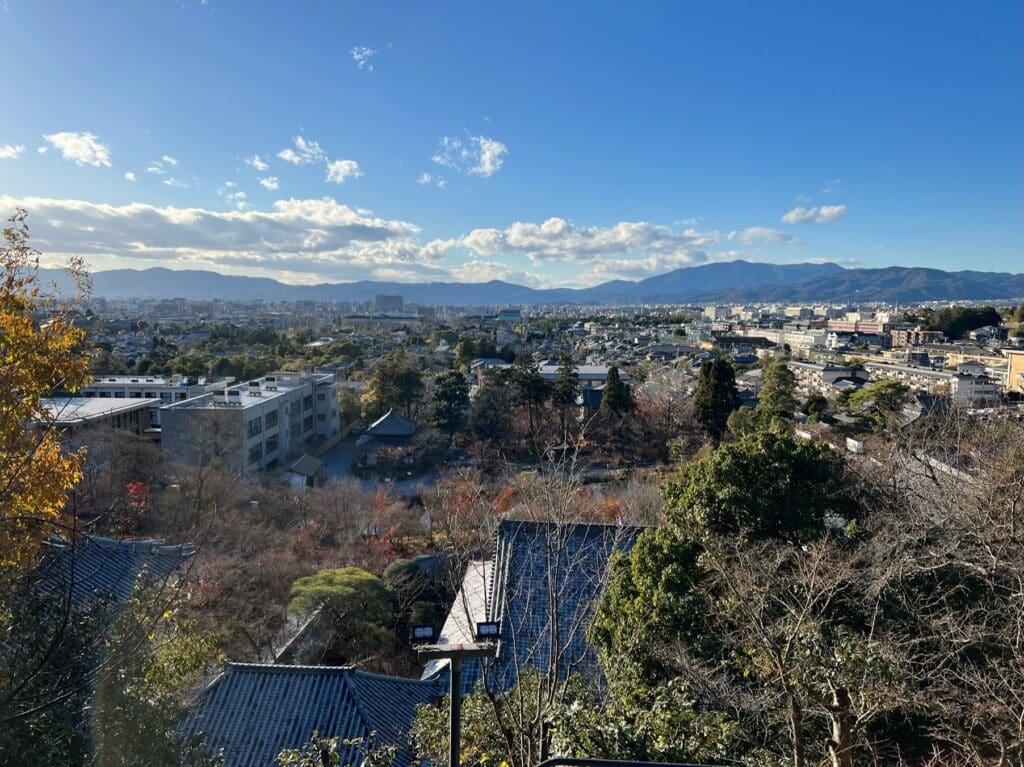
Some of the most famous things to see at Eikan-do temple include the Hojo pond and garden, the Miedo Hall which houses the statue of Amida Buddha with his head turned (Buddha statues usually have their head straight), the Tahoto pagoda, a two story structure that allows you to see the temple grounds from above, and its night illumination during fall foliage time.
Honen-In Temple (法然院)
Honen-in Temple is a tranquil and relatively secluded Buddhist temple along the Philosopher’s Path. Honen-in Temple was founded in 1680 during the Edo period. It was established in honor of Honen, a prominent Buddhist priest who founded the Jodo school of Buddhism.

The most well known feature of the Honen-In temple is its thatched roof gate and the sand garden. There is also a small pond and a stone bridge. Another unique feature of Honen-in is the Sesshin-no-Ma, a small meditation hall that provides a tranquil space for meditation and contemplation. Honen-in Temple often hosts seasonal events, including illuminations in the garden during the autumn season.
Ginkakuji (Silver Pavilion 銀閣寺)
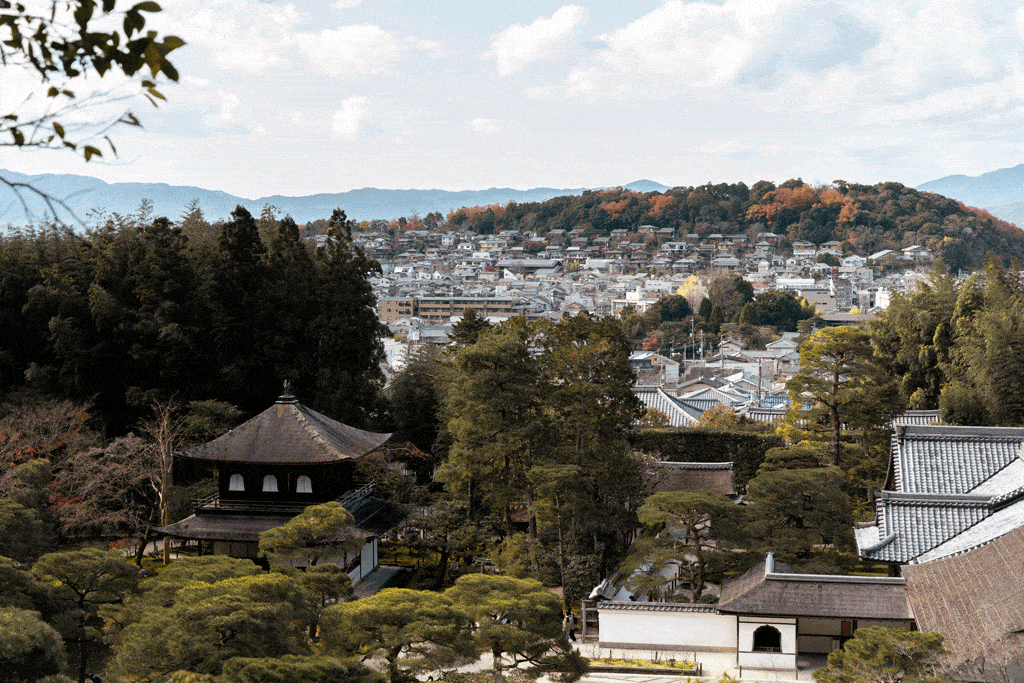

Ginkakuji is one of the most famous Buddhist temples in Kyoto. It was originally built in the late 15th century by Ashikaga Yoshimasa, the eighth shogun of the Ashikaga shogunate, as his retirement villa. After Yoshimasa’s death, the villa was converted into a Zen Buddhist temple.
The temple was modeled after the Golden Pavilion (Kinkakuji) built by his grandfather. While Kinkakuji is covered in gold leaf, Ginkakuji was originally intended to be covered in silver leaf, but it was never completed as intended.
Aside from the main hall, Ginkakuji is also known for its sand garden (Sea of Silver Sand), moss garden, and its viewpoint of the temple grounds and Kyoto.
Philosopher’s Path (哲学の道)

Philosopher’s Path is a 2km (1.2 miles) scenic walk along a canal in Kyoto between Ginkakuji and Eikan-do temple. The walk is peaceful and quiet and extremely popular during cherry blossom season in the spring. The path is lined with cherry blossom trees and you can visit a few smaller temples along the way.

You don’t have to walk the entire path to enjoy it, even a little bit would give you a feel of what it’s line to stroll down this path. There are some restaurants and food vendors on the path.
Evening: Explore Gion & Pontocho

Gion is a historical and culturally significant district in Kyoto. You may have heard of Gion especially when it’s in the context of Geisha, traditional Japanese female entertainers.
As you step into Gion, especially at night, you will feel like you’ve stepped back in time to ancient Japan with its traditional wooden townhouses and lanterns lighting up the streets. You will find a lot of private tea houses and restaurants in Gion and if you are lucky enough you can see a geisha (I’ve never seen one unfortunately).
Some of the best streets to walk around in Gion at night include Shinbashi Dori and Hanamikoji-dori.
Note that in 2024, Kyoto is banning tourists from some private alleys in Gion due to harassments of Geishas by tourists. You also cannot photograph Geishas. Please be respectful when visiting Kyoto and follow rules.

After exploring Gion, be sure to cross the Shijo Bridge (Shijo Obashi) to Pontocho, one of the most interesting streets in Kyoto.
Pontocho (先斗町) is a narrow pedestrian street lined with traditional bars, restaurants, and small shops. It is perfect for drinking and grabbing a snack.
Best Walking and Food Tours in Gion and Pontocho:
I highly recommend taking a night walking tour of Gion and/or a food tour of Pontocho Alley to fully experience the nightlife in Kyoto.
The Night walk in Gion Tour tells you the history of Geisha and you will learn pretty much everything about them from the way they dress, their hairstyles, makeup and the way they live.
The Pontocho food tour takes you to some really local spots to try food that you may not be able to find yourself. You get to stop by 5 food and drink stops and try 2 drinks and Japanese food during your tour.
Day 2 of 2 Days in Kyoto
During your second full day in Kyoto you will explore South Higashiyama to visit some of the most famous shrines.
If you can wake up enough, take a photo of Yasaka Pagoda before heading to Kiyomizu-Dera. Continue to explore Sannenzaka and Ninenzaka once the stores open. In the afternoon, hike up to Shogunzuka Mound for a beautiful view of Kyoto before visiting Kinkakuji, the golden shrine Kyoto is famous for.
Actually you have already been to south Higashiyama the night before! Gion is technically located in South Higashiyama.
Early Morning: Yasaka Pagoda (Hokan-ji Temple) Photo Spot (Arrive by 7am)

Yasaka Pagoda is the most photographed pagoda in Kyoto. The temple itself is small and most people try to take photos of the alley way with the temple in the background. If you see photos of Kyoto on Instagram this is probably the picture you see everywhere.
If you Google “Yasaka Pagoda Photograph Spot” you will find the exact photo spot to take that postcard picture. Or if you can’t find it, just search for “CAMPTON KIYOMIZU” and it’s right there.
Since all the Instagrammers and photographers try to get that perfect shot, you need to get there by 7am or earlier during peak cherry blossom season to get a photo without people.
Early Morning: Kiyomizu-Dera (Arrive by 8am)
Kiyomizu-Dera is an iconic Buddhist temple and an UNESCO World Heritage Site in Kyoto and it is one of the must-see temples. There are only a few “must-see’ temples in Kyoto in my opinion and this is one of them.
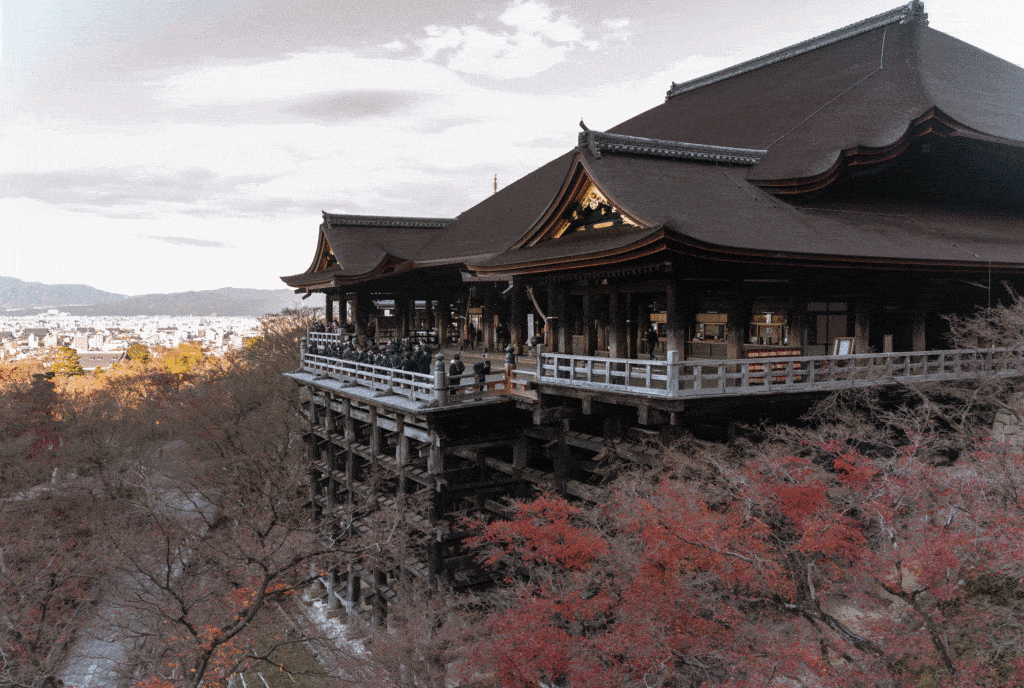
Kiyomizu-Dera temple is located halfway up Mt. Otowa and has over 1200 years of history. It is a large complex area and you will see several different gates and buildings. The main hall of Hondo is the most famous; its wooden structure stands on the cliff of Mt. Otowa.
The temple opens at 6am and you should aim to get there no later than 8am. We arrived around 8:30am and it was already getting crowded with tour buses!
Mid morning: Sannenzaka and Ninenzaka

After visiting Kiyomizu-Dera, walk down the main business street from the temple as all the stores and cafes are now open (they usually open at 9am).
Walk towards Sannenzaka and then Ninenzaka and check out all the souvenir stores or grab breakfast at a cafe. There are also plenty of street foods you can get in Sannenzaka, so be sure to try them!


Isibekouji
Isibekouji is one of the most atmospherical streets of Kyoto. It is a quiet pedestrian only alleyway that stretches no more than 200 meters, but you will feel like you’ve stepped into ancient Kyoto.
This stone-paved alleyway is lined with traditional Kyoto architecture which are mostly restaurants, inns, coffee shops and some bars.
You are not supposed to take photos here so keep that in mind when you visit.
Kodai-ji Temple
Kodai-ji Temple is a serene temple complex with beautiful Japanese gardens including a rock garden, a tea house and a bamboo grove. It is often not on first-time visitors’ radar but definitely a gem to visit.

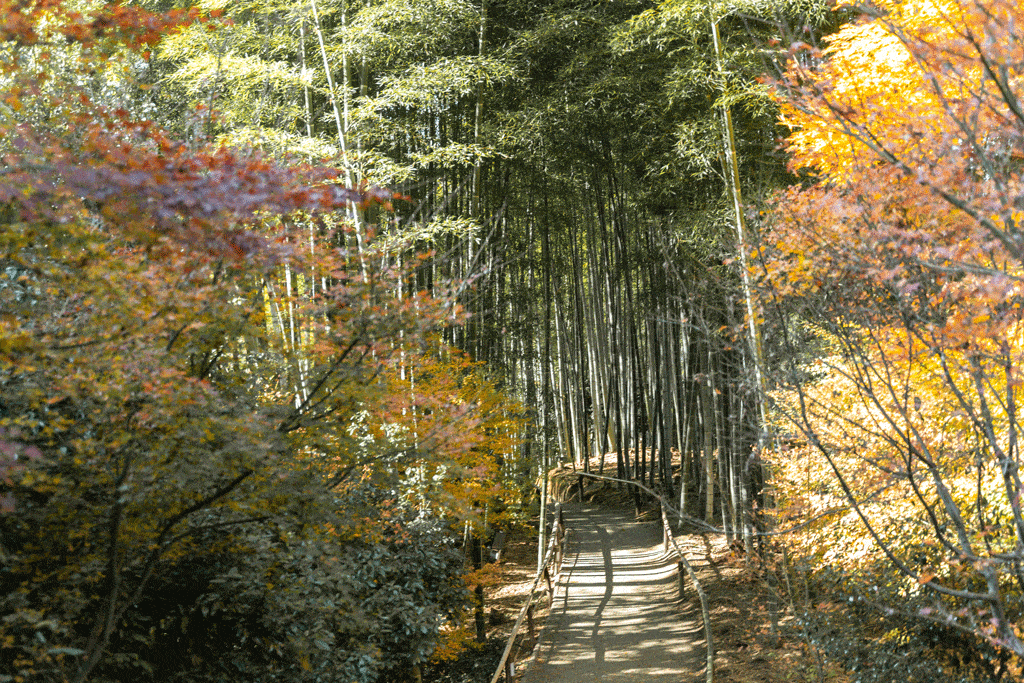
The bamboo grove there is not the famous one that you are thinking about, but it is a smaller yet still beautiful bamboo forest to see.
There are occasional cultural events that are being held at Kodai-ji Temple. It is also a nice temple to visit at night as it will be illuminated. Depending on the season you visit, the night illuminations do change.
After visiting Kodai-ji Temple, it is probably around noon. Grab lunch and dessert and take a break before we head out to the famous Kinkakuji.
OPTIONAL – Maruyama Park (円山公園) & Shogunzuka Mound (将軍塚)

Depending on how much time you have, you can consider (or skip) visiting Maruyama Park and Shogunzuka Mound. If you cannot finish visiting these two places by 3pm, you should skip it.
Maruyama Park is one of the most popular parks in Kyoto in Higashiyama area. Located right next to Yasaka-Jinja Shrine, Maruyama Park gets extremely crowded during cherry blossom season. Many flock to the park to see the weeping cherry tree and picnic under the beautiful cherry blossom.
You will find cafes in the park as well as a pond, Japanese garden, and restaurants.

If you have time, you can hike to or take a taxi to Shogunzuka Mound, one of the best observation decks in Kyoto. It is a 30 minute hike from the back of Chionin Temple next to Maruyama Park or a few minute taxi ride.
Afternoon: Kinkakuji (金閣寺)
Kinkakuji, otherwise known as Golden Pavilion, is a famous Buddhist temple in Kyoto and it is also a UNESCO World Heritage Site. Kinkakuji was originally built as the residence of the shogun Ashikaga Yoshimitsu but was later converted to a Zen temple after his death.

As the name implies, Kinkakuji’s top two floors are actually covered in gold leaves and this unique appearance attracts tourists across the world. The temple compound includes a pond and a few other buildings and gardens.
Kinkakuji is not located in South Higashiyama so you will need to either take a local bus or a taxi to get there. Remember that Kinkakuji closes at 5pm so you probably should get there no later than 4pm.
Evening: Yasaka-Jinja Shrine at Night (八坂神社)
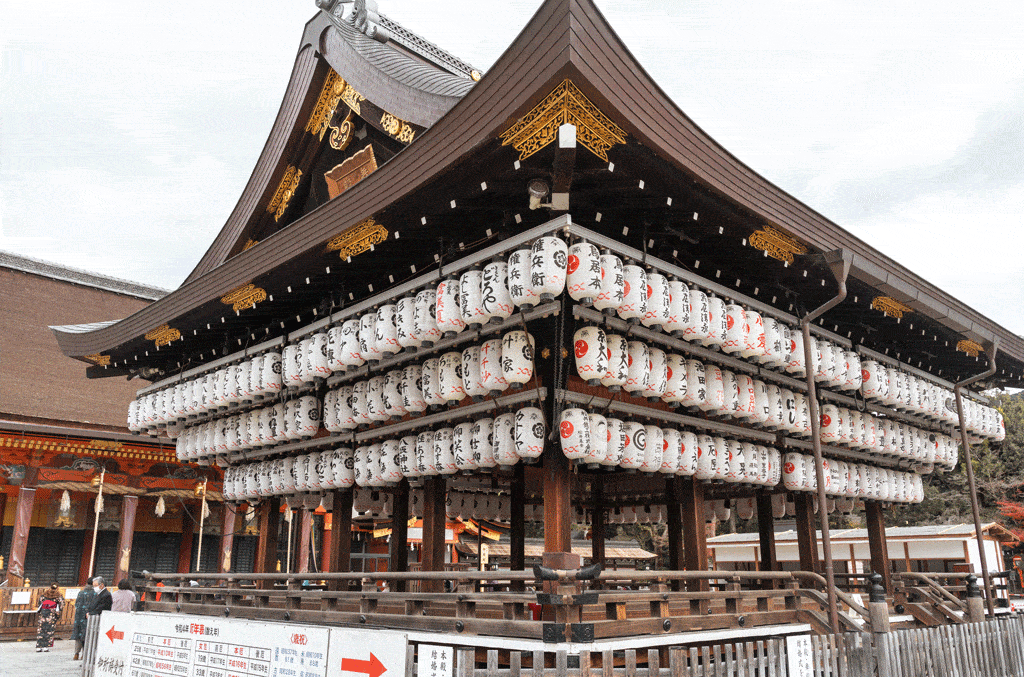
After dinner, if you are not too tired, walk back to Yasaka Jinja shrine in Gion. Although you can certainly visit this shrine during the day, it is actually one of those shrines that are better to visit at night because the building is illuminated with lanterns at night.


Is 2 Days Enough for Kyoto? How Many Days in Kyoto Do You Need?
2 days in Kyoto is the minimum amount of time you need to see the major attractions and experience the essence of this historical and cultural capital of Japan.
With 2 days in Kyoto you will not be able see everything; in fact, two days in Kyoto can barely scratches the surface of this amazing city! Besides the main tourist attractions that everyone goes to, Kyoto also has a lot of hiking trails, day trip options, museums, and less touristy hidden gems that will require more time.
Things to Do If You Have 3 Days or 4 Days in Kyoto
Two days really is pretty tight to see Kyoto since there is so much to do and see in Kyoto. If you have 3 days or even 4 days in Kyoto, then consider the following activities and tours.

- Nijo Castle: an Edo period castle built by Tokugawa shoguns. It is a UNESCO World heritage site and known for its gardens, beautiful architecture, art decoration and the history behind it
- Kyoto Imperial Palace: the former imperial family residence until the Imperial Court moved to Tokyo in 1869.
- Heian Shrine: a classic Shinto shrine built in 1895 to commemorate the 1,100th anniversary of the establishment of Kyoto as the capital of Japan. It is known for its architecture and gardens.

- Day trip to Nara: Located only about 30-40 minutes by train, Nara is the perfect day trip from Kyoto. You can visit Nara Park to see the famous temples such as Todai-ji and feed deer while you are at it. There are also hiking trails you can take, making it a very eventful day trip from Kyoto.


- Arashiyama Bamboo Grove: This famous bamboo forest is one of the most instagrammable spots near Kyoto! Located in Arashiyama, people from all over the world come to the bamboo grove for photoshoots although there are also many temples, gardens and other things to do nearby.
See my Arashiyama blogs on how to visit the bamboo forest and best things to do and eat in Arashiyama.


- Kyoto Tea Ceremony: a visit to Japan is not complete until you participate in a traditional tea ceremony, where you can learn about the history behind tea ceremonies, the different tea-making methods. You can book the Kyoto tea ceremony here.
- Samurai & Ninja Museum: If you love the samurai and ninja stuff from anime or Japanese history then you definitely cannot miss this museum. You can see all the armors, weapons and tools they used in real life in ancient Japan. You can also wear the samurai armor and use a sword and even do a basic ninja training at the museum. Book tickets on the official website.
- Nerd it out at the Manga Museum: If you love manga then you have to see the Manga Museum. There is a large collection of Manga (in Japanese) at the museum and you can certainly read for hours. If you don’t speak Japanese you may not get the full experience but it is still worth checking out as they do have some English ones. Book tickets here.
- Visit an animal cafe: if you are against animal cafes then you can certainly skip this. But if you want to see dogs or mini pigs in cafes in Kyoto then you are in luck. Mipig cafe has baby piglets you can interact with and there are several dog cafes nearby as well, such as Mameshiba cafe and Teacup club. If you want to see other people bringing their own dogs then you can stop by dog cafe K3.
Read Next: The best hotel to stay at to see Mt. Fuji
How to Get To Kyoto
Kyoto is super easy to get to from Osaka and Tokyo, making it an ideal place to visit for anyone visiting Japan.
There is no airport in Kyoto, the closest airport to Kyoto is Osaka International Airport (otherwise known as Itami Airport with the airport code ITM), followed by the Kansai International Airport (KIX) in Osaka. Yes, Osaka has 2 airports so be sure to make sure which airport you are landing in.

How to get to Kyoto from Osaka
Whether you are just landing in Osaka or you’ve been staying in Osaka, it is super quick and easy to get to Kyoto from Osaka.
From Osaka International Airport (Itami Airport), you have a few options to get to Kyoto.
- Airport Limousine Bus directly to Kyoto Station for ¥1,340 (~$10 USD); it takes about 1 hour
- Limousine bus to Shin-Osaka Station then take the JR Tokaido-Sanyo Shinkansen high speed train to Kyoto Station for ¥3,390 (~$25 USD), takes less than 1 hour. This is the fastest option
- Osaka Monorail then change to Kita-Osaka Kyuko line to Shin-Osaka Station and take the JR Shinkansen high speed train to Kyoto Station. This option costs ¥3,550 (~$25 USD) and takes a little bit over an hour
From Kansai International Airport, you also have a few options to get to Kyoto.
- Airport Limousine Bus directly to Kyoto Station for ¥2,600 (~$20 USD), takes 1.5 hours
- JR Haruka Limited Express Train to Kyoto Station for ¥3,440 (~$25 USD), takes 1 hour 40 minutes
- Non-JR trains to Osaka Station then switch to Tokaido-Sanyo Line to Kyoto for ¥1,910 (~$15 USD), takes 2 hours
It is even easier to travel to Kyoto from Osaka, taking only about 30 minutes on the train.
From Osaka Station, you can take the Tokaiso-Sanyo Line (¥580 or $5 USD, 29 minutes) or Haruka Train (¥1,670 or ~$14 USD, 32 minutes) to Kyoto Station.
From Shin-Osaka Station, you can take the Tokaido-Sanyo Shinkansen (¥2,670 or ~$20 USD, 18 minutes) or Tokaido-Sanyo Line (¥580 or ~$14 USD, 30 minutes) to Kyoto Station.
How to get to Kyoto from Tokyo
It takes a lot longer to travel from Tokyo to Kyoto compared to from Osaka, but since there are Shinkansen high speed trains, it makes the between Tokyo and Kyoto very easy, although it can be expensive.
From Tokyo Station, you can take the Tokaido-Sanyo Shinkansen train to Kyoto Station. It costs ¥13,970 (~$100 USD) and takes 2 hours 15 minutes.
From Shinjuku Station or any other stations in Tokyo, you will need to first get to Tokyo Station first then take the Tokaido-Sanyo Shinkansen train to Kyoto Station.
A lot of the trains above are JR trains, so it may be worth considering getting a JR West Kansai Pass if you plan to travel around the Osaka, Kyoto and Nara region by high speed trains or a JR Pass if you plan to travel around the whole Japan by high speed train.
Best Way to Get Around Kyoto
You can get around Kyoto by bus, subway, taxi, biking and of course, walking.
You can use an IC card (ICOCA if you land in Osaka, Pasmo or Suica if you visit Tokyo first) to pay for public transportation in Kyoto. You can get a physical card or get one with Apple Wallet.
But you can also get a one day subway pass OR a one day subway/ bus pass for Kyoto.

Getting Around Kyoto by Bus and Subway
Kyoto only has 2 subway lines, the Tozai Line and the Karasuma Line. The subway in Kyoto doesn’t really reach most of the tourist sites.
Buses are the main way of transportation in Kyoto. You can pretty much get to all the shrines and temples in Kyoto by bus (although you may need to transfer buses). You can see the detailed Kyoto bus and subway map on the official website.
In Kyoto, there is the city bus (green) and Kyoto bus (brown/ reddish). The City bus costs a flat fee of ¥230 per ride whereas the Kyoto bus (brownish one) charges by distance.
There used to be a Raku bus for tourists but those are out of service as of 2023.
You can use your one day subway & bus pass or you can use your IC card (or cash) to pay for the buses in Kyoto.
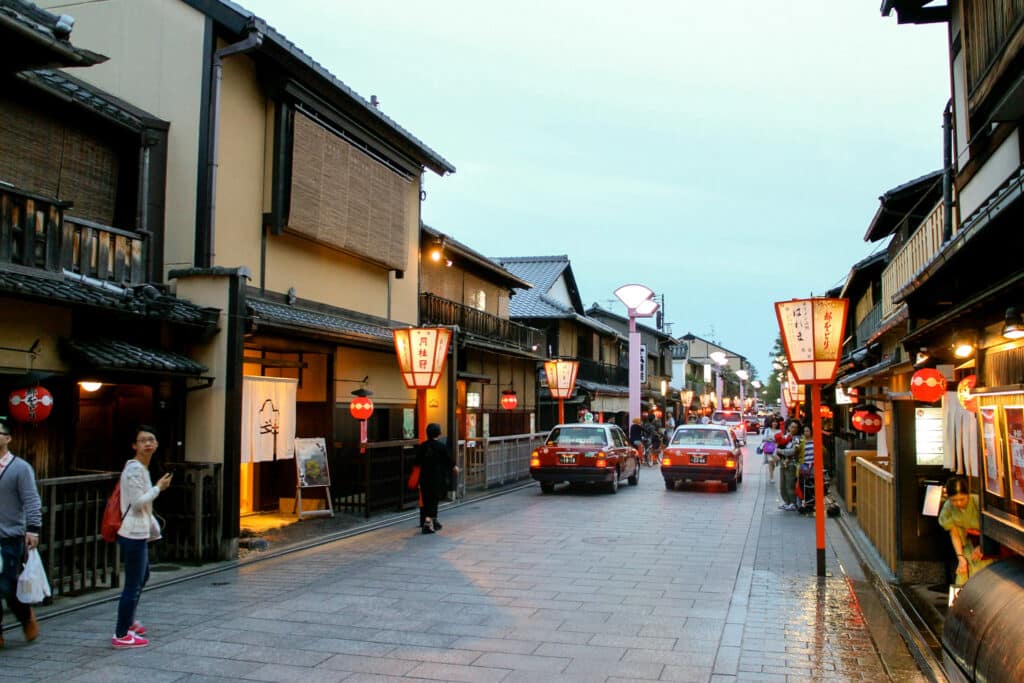
Getting around Kyoto by taxi
If you are traveling with a group of 4, then it might be better to take a taxi around Kyoto.
There are taxis everywhere in Kyoto, on the street, outside of the Kyoto station, waiting outside of major tourist attractions so you should not have any issue finding a taxi.
If you really want to use an app to get a taxi in Kyoto you should download GO App or Didi, both are more preferred than Uber. The Uber app works in Kyoto but keep in mind that all these apps will call a taxi for you, not a private car.
Getting around Kyoto by bike sharing
Kyoto buses can get really crowded, so another alternative you can do to get around is to do bike sharing.
Pippa is a bike sharing app in Kyoto. The app will show you a map with all the bike ports so you can rent/ return to any port you like. You can do a single ride or do a day pass.
Read Next: The perfect Kamakura Day Trip from Tokyo
Best (and worst) time to visit Kyoto for 2 or 3 Days
Spring (mid March to mid April) and fall (October and November) are the best months to visit Kyoto in the Kansai region.
You can see the world renowned cherry blossoms in Kyoto in the spring and beautiful foliage in late October and November. The weather will be much cooler during those months as well. However since everyone knows those are the best times to visit Kyoto, you can expect crazy crowds during peak cherry blossom and foliage time.
The worst time to visit Kyoto is in the summer (June to September) as well as the Golden Week in May. Even in September Kyoto is super humid and hot. I also got bitten by mosquitoes a lot in Kyoto in September. When I visited Kyoto just after cherry blossoms ended in April, the weather was perfect (just needed a jacket) and it was not as crowded.
Where to Stay in Kyoto for 2 Nights
Higashiyama area is the best area to stay in Kyoto; this is where you will find Gion, major shrines, shops, restaurants and bars. We stayed at Cross Hotel Kyoto and it was a great location with good value. You can also consider the GATE Hotel as well as GRANBELL Hotel.
Kamo River area north of Higashiyama is another decent area to stay in. It’s not too far from Higashiyama and it has good public transportation. If you want to stay in a Ryokan (Japanese traditional hotel) then check out Ryokan Sawaya Honten.
North of Kyoto station is another area you should consider. This area is convenient if you are arriving late to Kyoto by train or if you are planning to take the train early to Fushimi Inari. I stayed north of Kyoto station twice, once in a hostel called Hana Hostel and another time in a nice hotel called Hotel Kanra, which had a wooden Japanese tub and Japanese decor in the room.
Hostels in Japan are actually quite nice, at least from the few times I stayed in a hostel. All the beds have their own curtain, giving you a lot of privacy and the rooms were pretty quiet as well. You also have to take off your shoes to get inside, making the places feel a lot cleaner than hostels I’ve stayed everywhere else around the globe.

Travel Insurance For Kyoto
I always get travel insurance for international travels since so many things could go wrong (flight delayed, lost luggage, injuries, illness, accidents, etc). The insurance companies I always use are World Nomads or Safety Wing just for that extra peace of mind.
You can always build a quote just to see what they cover and how much it costs (not a lot actually).
World Nomads provides travel insurance for travellers in over 100 countries. As an affiliate, we receive a fee when you get a quote from World Nomads using this link. We do not represent World Nomads. This is information only and not a recommendation to buy travel insurance.
Other Japan Travel Planning Articles
If you are planning your epic trip to Japan, then you would love these other Japan travel articles!
- 10 Days in Japan: First Time Japan Itinerary
- How many days in Tokyo: the Ultimate Tokyo Itinerary
- Tokyo Bucket List: Street Mario Kart Guide
- Complete 2 Day Tokyo Itinerary
- Best Hotel Near Mt. Fuji: Kozantei Ubuya
- Osaka One Day Itinerary
- How to do a Day Trip from Osaka to Miyajima and Hiroshima
- Arashiyama Travel Guide: What to Do and Eat in Arashiyama
- How to Visit the Kyoto Bamboo Grove
- Kamakura Day Trip from Tokyo: A Complete Kamakura Guide
Like this post? Pin this 2 Day Kyoto Itinerary to Pinterest!

